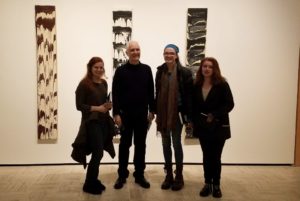The method of Katherine Eisenried
Setodzi Avoke
Junior Copy Editor

The compulsion to create for an artist can come in many forms. The natural world, an ideology or passion the artist feels the need to endear to their audience, translating the essence of areas or lifestyles exotic to the intended audience and more have all compelled some to develop or bend their talent toward that area of focus through infinite mediums.
Eisenried’s focus is basic but integral to humanity, particularly to those who are exalted among us for their talent at exercising the peaks of our form in sport or expressing some creative spark through pen, instrument, brush and more.
“My interest is in the brush mark as a mechanical product of the body,” said Eisenried.
Seeing Eisenried work for the first time, I saw admirable attention to gradient and form, but not the deeper aim that leads her desire to explore the deceptively simple world that exists between body and brush.
“The action and restrictions for creating a brush mark lie within a standard set by the human body,” continued Eisenried.
Given the scope of style and method within this set standard she mentions, the enormity of her study, to grasp all that the body may accomplish with brush. Her aim eclipsed the already impressive pencil sketch that exercised her competency with the anatomy of hands and gradient.
[This is what I was working on originally. However loosened creative writing is with regard to AP style/news writing, I feel this went too far for print]
Katherine Eisenried, Advanced Studies Student at Hudson Valley Community College
What thoughts and concepts inspire your work?
“I don’t see inspiration as a motivational factor in my work. Rather, I make art as a means of working through ideas by physical research. My interest is in the brush mark as a mechanical product of the body. The actions and restrictions for creating a brush mark lie within a standard set by the human body. The abstract expressionism movement showed interested in the hand and body as a single unit. These works incorporate brush marks as both a means of process and image. In relation, I explore the brush mark as a singular product. This product is then available for repetition and reviving the creation process by expending time.”
Could you describe any formative experiences that are reflected in your work?
“In Dec. 2016, I had an opportunity to meet with David Reed, an artist who gained recognition in the mid-70’s. Reed is also interested in brush marks as an act reflecting the impossibility of being entirely present in the moment. Reed has been an artist of my study and someone we have read about in our advanced studies course at Hudson Valley under Professor Thomas Lail. Some friends and I drove two hours to the Rose Art Museum at Brandeis University in Waltham, Massachusetts to hear him talk about his work. We were able to meet with him before and after his talk to ask questions, show our work, sign our sketchbooks and take a picture together. It was definitely an experience that fuels my ambition.”
Would you describe yourself as an aesthetically oriented artist, or a message oriented artist? Do you think it’s fair to make such a distinction between artists and their work?
“As I mentioned before, I view art as a means of working through an idea. If there is a concern for aesthetically pleasing the viewer, then they are not working through their own research. This is not a bad thing. I believe it is just a distinction between an artist and an illustrator.”
Would you mind speaking about the work you’re most proud of and the process that went into making it?
“It’s funny to me…to pick one I am most proud of, because I’ve only actually completed one work! My ideas are constantly flowing and it’s a never ending struggle to keep up with them. The piece I’m currently working on lends itself most directly to the ideas I’m interested in. The piece is 60”x64” on canvas with two brush mark centers, each measuring 48”. I created a large paint brush for this by combining two floor brooms. The marks are then covered with a thin layer of gesso before charcoal pencils draw on top recreate the brush mark.”
What’s your favorite medium to work on and with?
“I don’t have a firm answer for this since I don’t view myself as either a painter or a drawer. I’m caught in the middle. My work cannot be limited by a medium since the brush marks I create are with paint and the replication process is with charcoal. This may change in the future depending on the work. Upon meeting David Reed, he referred to a work as a drawing even though the brush marks were made of paint. I asked for his reasoning and he simply said “because it is on paper.” It was a straightforward response, but I was not expecting it. I believe this also influenced my simultaneous interests in drawing and painting. This is also why I don’t limit myself to a single medium.”
